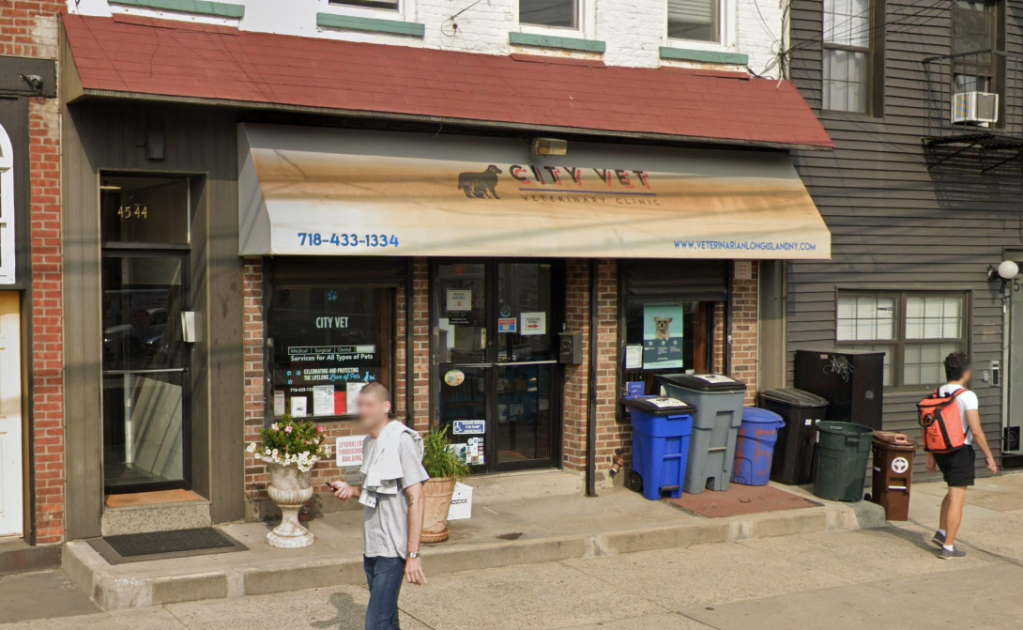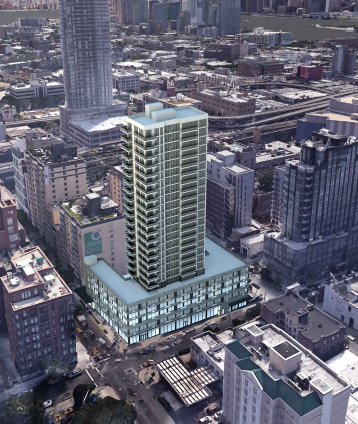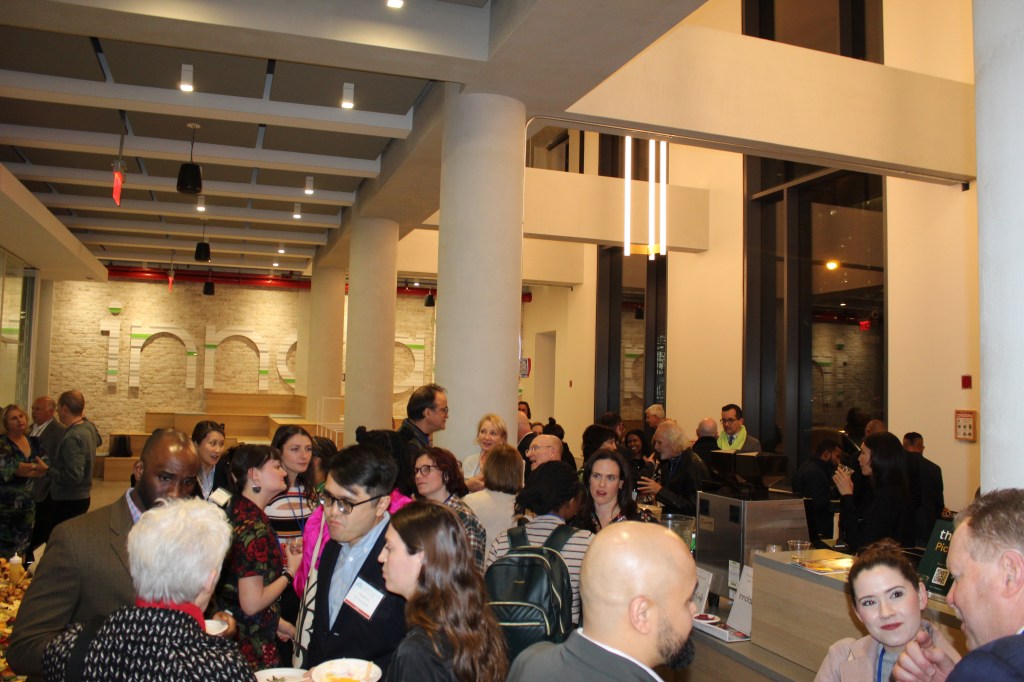From the rooftop of Silvercup Studios, Long Island City fans out in all directions like a gas-guzzling, oil-burning, construction-booming metropolis. Cars chug up the on-ramp to the Queensboro Bridge while the smokestacks of the Ravenswood Power Plant shoot skyward like rockets poised for flight, threatening to surpass the luxury condos rising on the waterfront.
Yet, in spite of this – or perhaps because of it – LIC is rapidly becoming the frontier of a “Green” revolution in New York City. Rooftop gardens are growing atop the local cityscape. Below ground, a utility giant is developing an energy-efficient “smart grid.” And somewhere in between, arts nonprofits are recycling and reusing materials, and area businesses are converting to solar power and cutting back on waste.
The gardener
LIC was a different place in 1983 when Stuart Suna and his brother Alan converted the former Silvercup Bakery into what would become the largest film and TV production facility in the city.
Twenty-five years later, Silvercup Studios now boasts another superlative; it is home to a 35,000-square-foot green roof, the biggest in the boroughs.
“I’m an environmentalist. I love landscaping. This will be my roof garden,” Stuart Suna recalled thinking four years ago when the idea of environmentally-friendly urban gardens was proposed at a meeting of the Long Island City Business Development Corporation (LICBDC).
The Sunas ultimately received a $400,000 grant from Clean Air Communities, a nonprofit dedicated to reducing air pollution and increasing energy efficiency, and chipped in an additional $100,000 of the studio’s money to create their rooftop meadow.
Several of the facility’s flat roofs are now home to rectangular expanses of hearty sedum – water-retaining plants – that can survive the Northeast’s harsh winters.
“Their roots are like giant sponges,” Suna said, squatting in a smart business suit to admire the small, tough plants that require little to no maintenance.
Absorbent “succulents” amount to less storm runoff, he said, which, in the end, means less sewage winds up in the East River.
As if a cleaner river wasn’t enough, Suna praised the plants for their insulation properties – they help keep the building cool in summer, warm in winter, and act as a sound-deadening system – and their respiratory benefits.
“The air feels much cleaner and fresher out here when you’re surrounded by green plants, because it’s actually scrubbing the air for you,” Suna explained, taking a whiff of the wind above 22nd Street.
He’s hopeful that the idea will catch on.
“A quarter of a million cars go over the bridge each day,” Suna said, adding that his rooftop might “inspire people to be more green in New York.”
The material girl
Just a few blocks away, Harriet Taub needs little inspiration to become more eco-conscious.
As director of the city-run Materials for the Arts (MFTA), Taub oversees a recently-expanded 35,000-square-foot warehouse that is equal parts recycling and reuse center, shopping mall, and classroom.
Last year, the 31-year-old MFTA collected 1.3 million pounds of film props, paint, tools, furniture, paper and other supplies – not to mention the plastic pink flamingos, vintage 8 millimeter film editors and removable dance floors that have come through its doors. The items, worth around $6 million, were stuffed into shopping carts by city-based nonprofits and school arts programs that get to roam MFTA’s aisles and shop to their hearts’ content – without dropping a dime.
“People talk about recycling, because you have to do that. But no one is talking about reuse,” said Taub, whose organization caters to around 4,000 registered groups and offers a tax deduction – as well as a warm, fuzzy feeling – to the set designers, event planners, architects and other business owners who routinely donate materials.
“Here’s the thing: If you’re a group, why spend money on filing cabinets when you can get a perfectly good filing cabinet from us?” she asked matter-of-factly.
Ainee Friedman, an art project teacher at P.S. 86Q, said MFTA is vital to her program’s survival.
“I could never have an art class if I didn’t have this stuff,” she said, before holding up a pair of oversized red holiday ornaments with a smile that seemed to say, “Christmas came early this year!”
“Budget cuts in my school are so severe that we don’t have computer paper,” Friedman added wistfully.
In fact, paper is the last thing arts groups have to worry about at MFTA. Taub said it’s the most popular item – and it’s not just run-of-the-mill white, but fancy patterned and textured stock from the likes of Martha Stewart.
“Anybody can be successful,” Taub said, glancing at a stack of Stewart’s paper and Michael Miller’s fabrics that are reserved for mask-making and other MFTA activities with student groups. “But, if given the right materials, you can be really successful.”
The “green business” guru
Dan Miner knows full well the importance of providing business owners with the tools they need to succeed. And, as the senior vice president of business services for the LICBDC, Miner’s support of local commerce has taken on an increasingly emerald hue.
“The value for businesses is figuring out what exactly does this ‘green’ mean,” and then devising a set of action steps, he explained.
With that in mind, in 2008 Miner and the LICBDC began assembling a Going Green Guide – available at licbdc.org – that serves as a step-by-step resource for cutting energy costs, increasing business efficiency, and reducing Long Island City’s commercial carbon footprint.
The 55-page guide leads local business owners through an evaluation process and delves into the ins and outs of building upgrades and maintenance as well as the “greening” of daily operations like waste, packaging and transportation.
The organization has received positive feedback on its work, though it has no way of tracking how many people have benefited from it since the guide is free to download, Miner said.
While he is aware of businesses that are in the process of installing solar panels and others that have created rooftop gardens, Miner said less exotic upgrades should take precedent at first.
“It’s good to talk about those things in order to give people a sense of the story and the narrative,” he said. “But where the rubber hits the road is where you have building superintendents making sure the boiler is tuned up properly.”
He went on, “Making sure that you have lower bills – that’s the important stuff and then we throw in the other glamour stuff, too.”
Living off the grid
There can’t be too many things less glamorous than working belowground to modernize Northwest Queens’ electrical distribution. But that’s just what Con Edison has done with its Smart Grid pilot program, an initiative that seeks to improve the flow of power and ultimately deliver electrical sustainability to Long Island City, Astoria, Sunnyside and Woodside.
The program, which was launched in August with a primary investment of $6 million, features an underground intelligence system that allows for the monitoring of electrical distribution and the isolation of any problems that arise.
Another key component, explained Con Ed spokesperson Sara Banda, is smart building technology that will allow 300 initial consumers to monitor their power usage through an in-home display. The hope, Banda noted, is that a more informed consumer is a more efficient consumer.
Additionally, the Smart Grid pilot program will include tests to determine how to better integrate renewable energy resources into the grid, and Con Ed expects to use the data gleaned from its trials to implement system-wide upgrades.
Banda said Con Ed chose Northwest Queens as the site for its pilot because “it’s an area that encompasses commercial, residential and industrial” buildings and Long Island City is home to the utility company’s Learning Center.
In fact, the Vernon Boulevard Learning Center boasts its own green roof – with more than 21,000 heat-absorbent plants – but Con Ed is also among the staunch proponents of an altogether different energy-efficient roof treatment.
Is white the new green?
There they were – a former Vice President of the United States and the Mayor of New York City in short-sleeves, holding paint rollers and freshening up the roof of the LIC YMCA.
For around two weeks in September and October, volunteers climbed atop six flat roofs in LIC – starting with the Y on September 24, and moving on to the LIC Community Boat House, MoMA QNS, Flux Factory, Film Biz Recycling and the 114th Precinct – and slathered white paint on 100,000 square feet of black tar as part of the NYC Cool Roofs campaign.
The energy-saving pilot program, launched by Al Gore and Michael Bloomberg, among others, was the result of a partnership between NYC Service – the Mayor’s volunteerism program – the Community Environmental Center (CEC) and Green City Force.
“It’s such a simple concept – anyone who has ever gotten dressed in the summer knows it – light-colored surfaces absorb less heat than darker surfaces do,” Bloomberg said in announcing Cool Roofs.
And in Long Island City, according to the Mayor, there are plenty of dark industrial rooftops that lead to higher than average temperatures in the neighborhood.
White roofs, he noted, absorb 80 percent less heat than dark roofs and can decrease roof temperatures by up to 60 degrees and indoor temperatures by 10 to 20 degrees on hot days.
CEC, a green building consultancy, believes that painting all New York City rooftops white would lower the city’s summertime temperature by one degree – which would save tenants $100 million in energy costs.
The city expects the Cool Roofs initiative to help it achieve its goal of reducing greenhouse gas emissions by 30 percent by the year 2030, which is championed in the city’s PlaNYC sustainability plan. The next phase of the initiative is scheduled for other parts of the city in the spring.
Gore, the founder of the Alliance for Climate Protection, called the threat of the climate crisis “unsurpassed” and praised New York City for its “smart policies” that are helping to address the challenge.
“Thanks to the efforts of Mayor Bloomberg, New York City remains at the forefront of enacting innovative policies that reduce our carbon footprint,” he said at the September 24 Cool Roofs kick-off.
And thanks to the nonprofits, the artists, the businesses and the visionaries, Long Island City has emerged as a true leader in New York City’s green revolution – and those behind the movement say they’re just getting started.



































